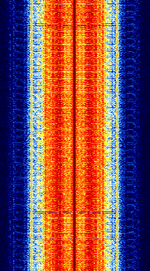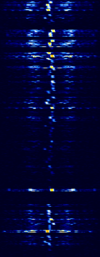Automatic Vehicle Monitoring (AVM)
 | |
|---|---|
| Frequencies | 517.875 MHz,507.225 MHz |
| Frequency Range | 507.225 MHz - 517.875 MHz |
| Mode | NFM |
| Modulation | FFSK |
| ACF | — |
| Emission Designator | — |
| Bandwidth | 7.5 kHz |
| Location | Australia |
| Short Description | Proprietary FFSK data network used for public transport telemetry. It is primarily used to track and control vehicles, and facilitates PTT-ID for communication with tram drivers. |
| I/Q Raw Recording | Download file |
| Audio Sample | |
The Automatic Vehicle Monitoring (AVM) system was implemented on Melbourne's public Bus and Tram network in the 1980s. It is primarily used to track and control vehicles, and facilitates PTTPush To TalkPress to TransmitMinistries of Postal, Telephone, and Telegraph Service (Soviet Agency)-ID for communication with tram drivers.
There are five fleet controllers (see frequencies) which send a poll to each vehicle every 10 seconds, and the tram will transmit its current location, route, distance, speed, door status, alarms along with some other data, including odometer information on the uplink frequency.
Since 2009 the AVM data feeds the PIDs at tram stops and stations, as well as the TramTracker app for mobile devices.
Frequencies[edit]
- Voice Channels
| Channel | Frequency (MHzMegaHertz (MHz) 10^6 Hz) | Usage | Note |
|---|---|---|---|
| 9 | 507.200 | Fleet Ops | |
| 14 | 507.250 | Unknown | TGID Patch 64305 |
| 10 | 507.275 | Unknown | TGID Patch 64304 |
| 13 | 507.300 | Fleet Ops | TGID Patch 64307 |
| 16 | 507.600 | Fleet Ops | |
| 8 | 507.700 | Fleet Ops | TGID Patch 64306 |
| 15 | 507.850 | PA Announcements | Replaced with DMR TIII in July 2025 |
| 11 | 508.450 | Events | Replaced with DMR TIII in July 2025 |
| 12 | 509.375 | PA Announcements | TGID Patch 64312/64313 |
- Data Channels
| ID | Frequency (MHzMegaHertz (MHz) 10^6 Hz) | Location | Note |
|---|---|---|---|
| 507.225 | Melbourne Central Tower | ||
| 507.500 | Melbourne Central Tower | ||
| 507.550 | Eureka Tower | Replaced with DMR TIII in July 2025 | |
| 507.575 | 101 Collins Street | ||
| 507.875 | Rialto Towers |
Samples[edit]
- Uplink
This sample below is the uplink channel. Note the rapid FFSKFast Frequency-Shift Keying data bursts from multiple mobile units:

- Voice Transmissions
Data is also transmitted at the end of each mobile voice transmission:
Tram driver communication:
Short conversation between driver and dispatch: